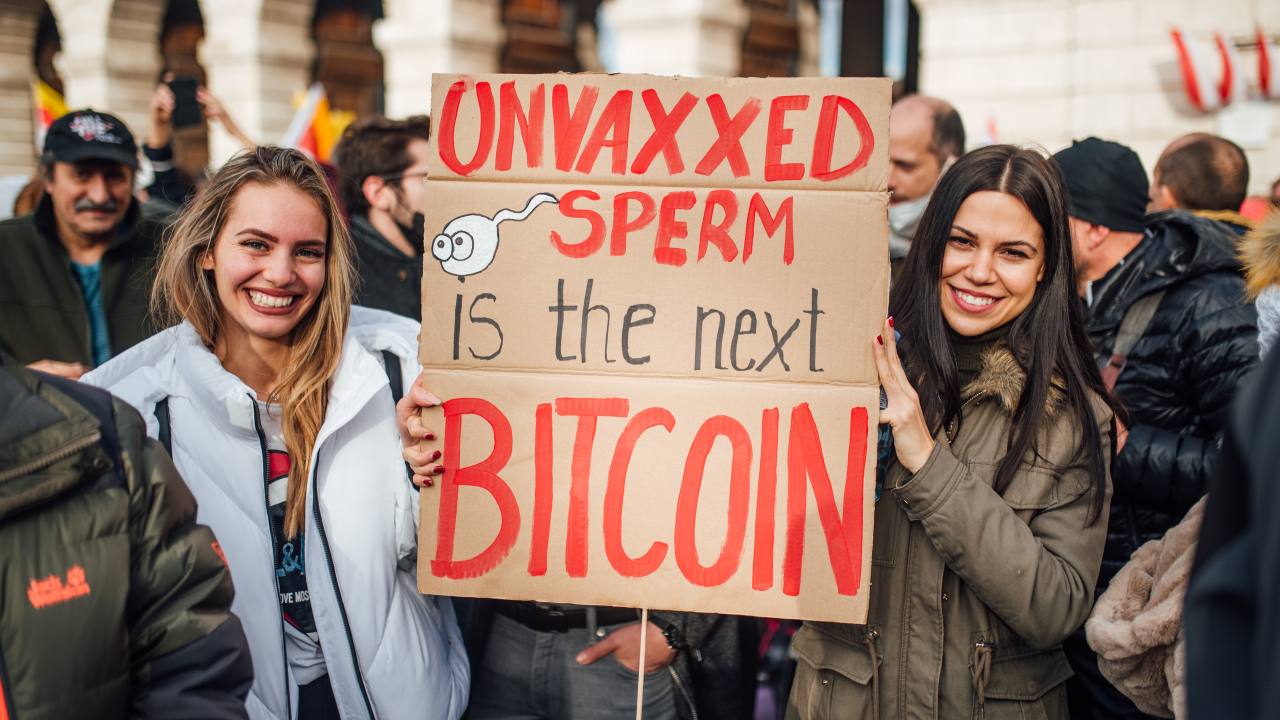Quick overview
The phrase “unvaxxed sperm is the next Bitcoin” became a meme in 2021 and inspired token experiments. The case “Unvaxxed Sperm” shows the usual sequence: viral slogan, rapid token launch, social hype, very thin liquidity. Price portals list such traces; visibility is not a substitute for substance or due diligence.
Genesis: from sign to token
The starting point was a photo from Vienna on 20/11/2021. The claim fused protest culture with crypto buzzwords. Shortly afterwards, token pages surfaced on price aggregators monetising the catchphrase. The pattern is typical: attention is declared an asset.
Case “Unvaxxed Sperm”
Price sites list entries for “Unvaxxed Sperm” (e.g., UNVAXSPERM or NUBTC) – often with no real trading volume or only a handful of micro‑trades. This illustrates that attention does not equal legitimacy or quality. For a quick market reality check, neutral listings such as CoinGecko and CoinMarketCap are useful.

How meme coins work
Meme coins are usually attention projects. Common building blocks include cloned smart contracts, central developer keys, soothing labels like “renounced” or “liquidity locked”, marketing roadmaps without a product, short lock periods and aggressive social pushes. Supervisory authorities have warned about these patterns for years without criminalising meme coins per se.
On‑chain red flags
- High concentration among a few wallets – increased risk of abrupt sell‑offs.
- Contract functions such as mint, tax or blacklist logic – can steer transfers or reroute fees.
- “Ownership renounced” as reassurance – says nothing about backdoors added beforehand.
- Short or opaque liquidity locks – liquidity can be withdrawn after unlock.
- Bridges/wrappers to other chains – offshoots can be manipulated independently.
- Hacked social accounts or launchpad hype – classic triggers for pump‑and‑dump cycles.
Price & volume
Typical hallmarks are zero to tiny volumes, steep one‑minute candles in thin pools and “burn” screenshots used as marketing. Always check: size of the liquidity pool, distribution of top holders, and real counterparties on the DEX. A listing is just one data point, not a seal of approval.
| Signal | What it suggests | How to verify |
|---|---|---|
| “Renounced/Locked” | Builds perceived trust | Read contract code and timelocks; note unlock dates |
| “Burn” screenshots | Creates an impression of scarcity | Check the transaction hash: real burn or just a wallet transfer? |
| Sharp moves in minutes | FOMO in illiquid pools | Check order depth, pool size, top holders, counterparties |
Legality & ethics
A meme coin is not automatically illegal or inherently fraudulent. In many jurisdictions, creating a useless, speculative token is legally possible so long as no other laws are violated (e.g., securities, fraud or anti‑money‑laundering rules). What matters are disclosure, marketing claims and the initiators’ actual behaviour. Regulators emphasise: high risk, but no blanket criminalisation. Consumers should proceed cautiously and verify claims. Useful starting points include notices and warnings from the BaFin, the SEC, the CFTC, and the Swiss FINMA warning list.
Toolbox
- Inspect the contract: owner/proxy, mint/tax/blacklist, verified source, timelocks.
- Check holder structure: largest wallets, team escrow, movements before/after listings.
- Assess liquidity: pool size, lock duration, valuation versus liquidity.
- Social forensics: airdrops, celebrity posts, launchpads – verify identities, use 2FA, avoid phishing.
- Read the rules: BaFin/SEC/CFTC/FINMA guidance, local obligations and reporting routes.
Medical fact check: Do vaccines make sperm “bad”?
The current evidence does not support a lasting negative effect of COVID‑19 vaccination on male fertility. Prospective measurements before and after mRNA vaccination show stable semen parameters (volume, concentration, motility, morphology); systematic reviews confirm this overall picture. National and international authorities report no fertility safety signal. In contrast, infections – especially with fever and inflammation – can temporarily impair semen parameters, usually recovering within weeks to months. Biologically, there is no plausible mechanism for vaccine‑induced germ cell damage: vaccine mRNA remains in the cytoplasm and is rapidly degraded; genomic integration is not expected, and proposed cross‑reactions (e.g., “syncytin‑1”) are not evidenced. In practice: if in doubt, a WHO‑standardised semen analysis provides orientation; after fever or acute illness, allow roughly 72–90 days before repeat testing.
- Prospective cohort with before/after measurements: no deterioration in volume, concentration, motility or morphology after mRNA vaccination (Gonzalez et al., JAMA 2021).
- Systematic review/meta‑analysis: no clinically relevant effects of COVID‑19 vaccination on semen parameters; consistent findings across studies (Ma et al., 2023, PubMed; Li et al., 2023).
- Authority conclusions: vaccinations do not impair fertility; recommendations on family planning are unchanged (CDC; WHO; RKI; Swissmedic).
- Infection vs vaccination: after COVID‑19 illness, temporary quality dips are more frequently reported (fever/inflammation); values typically normalise within weeks to months (see reviews above).
- Mechanism: vaccine mRNA stays in the cytoplasm and is degraded; genome integration or lasting germ cell damage is biologically implausible (see WHO/CDC resources above).
- “Syncytin‑1” claim: no robust evidence for a clinically relevant cross‑reaction; large reviews find no such risk (see meta‑analyses).
- Practical note: use WHO‑standard semen analysis; after fever/acute illness, wait 72–90 days to cover a full maturation cycle (WHO Laboratory Manual for the Examination and Processing of Human Semen, 6th ed., 2021).
Conclusion
“unvaxxed sperm is the next Bitcoin” was a catchy line. The token spinoff shows the common pattern of many meme coins: lots of attention, little foundation, perceived safety in place of real governance, visibility in price apps instead of robust liquidity. A serious assessment requires on‑chain checks, liquidity and holder analysis, and a look at regulator guidance. Medically, the vaccine narrative behind the slogan does not hold up.

